|
FAQs about Marine Snail
Identification 20
Related Articles: Gastropods, Sea Slugs, Mollusks, Abalone,
Related FAQs: Snail ID
1, Snail ID 2, Snail ID 3, Snail
ID 4, Snail ID 5, Snail ID 6, Snail
ID 7, Snail ID 8, Snail ID 9, Snail ID
10, Snail ID 11, Snail ID 12, Snail
ID 13, Snail ID 14, Snail ID 15, Snail ID
16, Snail ID 17, Snail ID 18, Snail ID
19, Snail ID 21, Snail ID 22, Snail
ID 23, Snail ID 24, Snail ID 25, Snail
ID 26, & Marine Snails 1,
Marine Snails 2, Marine Snails 3, Invertebrate ID, Snail Behavior, Snail Selection, Snail Compatibility, Snail Systems, Snail Feeding, Snail Disease, Snail Reproduction, Mollusks, Sea
Slugs, Abalone,
|
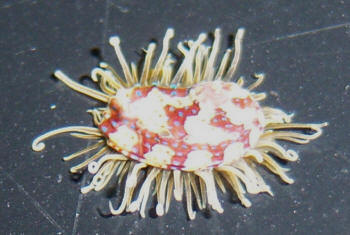
|
|
Cone Shell Snail? Nope, Likely Marginellid --
9/5/09
<Hello Ron, Lynn here today.>
I finally managed to catch this little guy that I've seen now
and then.
<What a little beauty!>
It looks a bit like a cone shell snail to me but a more expert
opinion would be great.
<It does indeed look a bit like a cone snail (family:
Conidae), or even a type of olive (family: Olividae), but the
shape/thickened outer area of the lip is inconsistent with either
group. It appears to be what's commonly called a Marginella,
or 'margin' shell (family: Marginellidae). If your snail
originated anywhere from the coast of North Carolina to Florida,
the Gulf of Mexico, West Indies or Mexico, it's most likely
Prunum apicinum (aka the Common Atlantic Marginella). These
beautiful little shallow water snails only reach around 14mm
(just over half an inch) in total length and are sand-dwelling
carnivores and scavengers. They emerge en masse when they smell
food/prey and pile on, grabbing whatever bits they can, as fast
as they can. They then drag any sizable items back under the sand
to consume. One thing of note is that these snails have a decided
appetite for other Molluscs, including clams, limpets, Cerith
snails, olive snails, etc., so if you have any of these in your
tank, watch out. If that's not an issue, I'd offer the
little fellow meaty bits of marine origin (an opened fresh clam,
bits of shrimp, fish, etc.) and enjoy the show! Please see the
following links for photo comparison:
Note variation in color: http://www.jaxshells.org/prunumx.htm
Good close-up of a live individual:
http://205606.aceboard.net/205606-2058-7943-0-Prunum-apicinum-Menke-1828.htm
>
It is less than half an inch long. So it could still be a
juvenile of something?
<If it is indeed P. apicinum, then yes, judging by the size
and relative transparency of the shell (that becomes less so with
age), it's not quite an adult. The beautiful black and white
pattern you see is actually the underlying tissue!>
Thanks,
<It was a pleasure, Ron.>
Ron
<Take care, LynnZ>
|
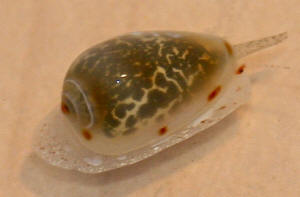 |
|
Help With Snail Please: Florida Crown Conch -
6/23/09
<Hello Shelly, Lynn here today>
I have found this large snail...can't find out anything about
it.
<The common name is the Florida Crown Conch, a carnivorous
predator/scavenger that inhabits intertidal/some subtidal areas:
mud flats, oyster beds, estuaries, salt marshes, and such. This
species (Melongena corona) varies considerably in size, color,
and shape, which has unfortunately led to some taxonomic
confusion and debate. The various morphs are generally considered
either one of several species/subspecies within what's known
as the 'Melongena corona complex', or simply as a variant
of the single species: Melongena corona. Please see the following
links for more information:
http://www.sms.si.edu/IRLSpec/Melongena_corona.htm
http://zipcodezoo.com/Key/Animalia/Melongena_Genus.asp
>
I have it in my saltwater tank. It was found at the Ponce inlet
in New Smyrna beach Florida.
<Okay>
I have tried to look it up; I know it is some kind of venomous
cone snail
<No worries, it's not a cone snail or venomous.>
....but it is so prehistoric looking...like nothing I can
research.
<It is indeed an interesting looking snail. Thankfully
there's a lot of available information on the 'net and
elsewhere -- just use the terms above.>
Can you help me identify it or pass me on to someone who can?
<I think we've got it!>
Thank you
<You're very welcome>
Shelly Broussard
<Lynn Zurik>
The picture does not do him justice...he is LARGE!
<Yes, Crown Conchs can apparently get pretty sizeable (up to
~8').>
It has the "shooter" thing that comes out the one hole
on the end of the shell...
<Well, while Melongena species and cone snails both have a
proboscis (long tubular feeding organ), only the cone snail has
the added venomous harpoon-like device. Melongena species'
main diet consists of bivalves and other gastropods/snails
(including each other), dead or dying animals, and possibly
ascidians/tunicates. Harpoon-like devices and fast acting venoms
are handy for capturing and subduing active/struggling prey, but
in the case of Melongena species' prey, it's overkill.
Their main prey items aren't going to suddenly swim away.
These snails typically use their long proboscis to work between
the two halves of a bivalve and feed bit by bit on tissue removed
by means of tiny 'radular' teeth.>
..then like a head and face under that with two
"antenna" things on it. He glides around the tank on
large mass
<The "foot">
that has a hard bottom on it.
<What you may be seeing is the snail's oval operculum
(trap door at the opening of a snail that protects the soft body
inside from predation and desiccation).>
He mostly stays buried in the sand...but when he does move he is
fast!
<That's pretty typical. When they smell food, they erupt
out of the sand!>
I have had him in my tank for over 6 months...and just saw him
kill a fish!!!!
<Yikes! Although healthy/live fish are not usually on the
menu, these are opportunistic snails that will take advantage of
any food opportunity that comes their way. They've got big
appetites and are not picky. You might want to offer your snail a
bit more food -- clams, fish, shrimp, etc., to hopefully deter
further predation. If that doesn't work, you'll need to
remove one or the other to another tank.>
I tried to look him up and found other poisonous cone
snails....sort of like him...but nothing close! If he is
endangered
<Nope, it's a common snail.>
or of scientific use I would like to turn him over to the proper
people. I have been collecting things out of the Indian River and
Atlantic Ocean in the New Smyrna beach area for over 25 years
<I know it's tempting, but we do try to discourage people
from doing this because so many find out too late that
they're unable to care for an animal long term. Also,
collection is regulated or prohibited in many coastal areas. Here
are two links to the new Florida regulations that take effect
July 1:
http://www.floridaconservation.org/RULESANDREGS/Saltwater_Regulations_recharvestmls.htm
http://www.floridaconservation.org/RULESANDREGS/Saltwater_Regulations_recseashells.htm
>
...and have NEVER found anything like this!
Thank you again.
<You're very welcome again! Take care, LynnZ>
|
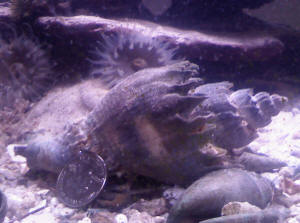 |
Slug/Snail Type Hitchhiker: Stomatella -
5/21/09
Hello WWM crew.
<Hello, Todd>
I was staring at my tank as usual, when I came across this
slug/snail looking hitchhiker. It appears to have some sort of
shell on it, and a "tail". It also has 2 antennae/feelers
on the front.
<It's a very common and beneficial little gastropod in the
genus Stomatella. These herbivorous grazers are a completely
harmless and welcome addition to anyone's cleaning crew. For
more information, please see the following links: FAQ titled
'Hitchhiker Snail Reproduction: Stomatella varia -
1/17/08': http://www.wetwebmedia.com/snailreprofaq2.htm
http://bb.wetwebmedia.com/viewtopic.php?f=25&t=181>
Google 'Stomatella' in our search engine for numerous
additional FAQ's re: http://www.wetwebmedia.com/Googlesearch.htm
>
My tank is a 300g FOWLR for now, planning on turning it into a
reef. For fish I have a pair of O. clowns, a pair of maroon clowns,
a purple tang, orange shoulder tang, yellow tang, blue/regal tang,
Kole tang, Foxface, and asfur angelfish. I have maybe 10 small
mushrooms, and 20 or so zoo's (pretty much nonexistent in a
tank this size), also a frag of frogspawn, and a RBTA (split into 2
about 3 months ago), and a GBTA (just split into 2 about a weeks
ago, it was HUGE before the split, at least 8-9" across).
<Wow!>
I also have a few peppermint shrimp, a few cleaner shrimp, some
emerald crabs and sally Lightfoot crabs,
<Watch out for the crabs, especially the sally Lightfoots. They
start off small and fairly innocuous, but turn into very swift and
effective predators as they mature. They're known for killing
fish, hermits, shrimps, and smaller crabs, tearing up anemones and
corals (to get to what's in their guts), as well as being a
challenge to trap. Emerald crabs, like just about every other crab
out there, are opportunistic and can be a problem as well, but not
as much as the sally Lightfoot. For more information on either,
please see WWM (see the above search engine).>
..hermit crabs, tons of snails, feather dusters etc...
Any help in identifying this creature would be greatly appreciated,
that way I can either put him back in the tank, or get rid of
him.
<This is one little fellow you want to keep!!>
Thanks in advance
<You're very welcome.>
Todd Angus
<Take care, LynnZ> |
 |
|
Are These Baby Turbo Snails? Chitons and Mystery
Critter -- 5/15/09
WWM Crew:
<Hello, Jesse>
I recently had an outbreak of Asterina starfish in my reef tank
so I've been paying close attention to my rock work and
removing them as I see them.
<Not fun. Most of the time those little guys are harmless but
if/when you get too many or if you get a variety with a taste for
your favorite coral - yikes!>
While on starfish patrol I noticed an abundance of small (ant
sized) creatures I haven't seen on my rock work before. I
removed a few and photographed them...see attached.
<I see, thanks.>
They appear to be snail like, having a protective shell and a
soft gooey body.
<Hmmmm, crunchy on the outside, gooey in the middle. Sounds
like a Baby Ruth bar! Actually, what you have are harmless and
beneficial little critters commonly called Chitons, or more
specifically, Polyplacophorans. This particular variety is one I
have in my tanks and has never caused any problems. They're
herbivorous grazers of hard surfaces, stay small, and apparently
reproduce quite readily in captivity. All in all, they're a
welcome addition to a reef tank. Here's a photo of several of
mine for comparison (these are about 3mm long):
http://bb.wetwebmedia.com/gallery/pic.php?mode=large&pic_id=126
.
For more information on Chitons, please see the following WWM
links, starting here: http://www.wetwebmedia.com/chitonfaqs.htm
http://bb.wetwebmedia.com/viewtopic.php?f=25&t=298&p=3108#p3108
>
I've also noticed that almost all of the 3-7mm sized snails
in my tank have white spots/growths on their shells. I have also
attached a picture of this but it's of poor quality.
<I'm sorry, but I can't see the subjects well enough
to be able to determine what anything is. If you could take one
out and get a more detailed photo that would be super. If you
could get photos from several angles, including the opening it
would be even better!>
Also, these creatures only come out at night,
<If you mean the Chitons, that's completely
normal.>
..the same time as the baby snails with the spots on them. What
do you think these creatures are, and are they a threat to my
reef tank?
<I doubt it, but it's always nice to be able to confirm
that. Have you noticed any sort of damage/sign of trouble? Do try
to get some additional photos of these critters and we'll see
if we can't figure out what they are.>
Thank you in advance,
<You're very welcome. I look forward to solving the
remaining snail mystery!>
Jesse
<Take care, LynnZ>
|
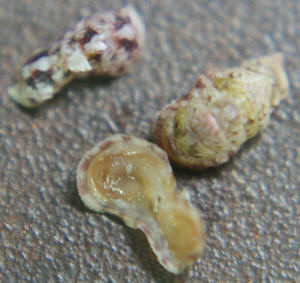 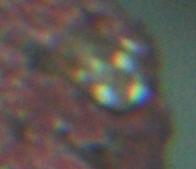 |
|
Snail ID: Olive -- 5/15/09
Hello again WWM Crew!!!
<Hello Sandra!>
I am in need of a snail identification, please.
<Sure thing, let's get to it.>
This big guy had to have hitchhiked in on my live rock about 6
months ago. I had been trying to catch him for about a month.
He's nocturnal and hides very quickly when you shine a
flashlight on him.
<Yep, they can move surprisingly fast for a snail!>
I have only seen him on the rocks, never on a coral or the
sand.
<These guys like to burrow/bury themselves in the sand, but
emerge to hunt/forage -- mostly at night.>
I've looked at that snail ID site that has all of the shells
on it and the only thing similar that I have seen is a cone snail
but I don't really think he's a cone snail.
<You're right. What you have is commonly referred to as an
Olive snail (family: Olividae, genus: Oliva). I wish I could give
you the species name, but I'd need the snail's location
of origin in order to even begin to narrow things down. Further
complicating matters is the degree to which these snails can vary
within a given species. From what I've seen, your snail might
well be Oliva(Miniaceoliva) miniacea, of which there seem to be
many subspecies. One thing that's a bit odd about your snail
is the shape of the opening at what most people think of as the
bottom end of the shell (opposite end from the spire). As
you'll see in the photos linked below, most Olive snails have
an obvious notch at the end (called a siphonal notch). Yours has
a siphonal canal -- an extended tube-like structure more common
to Murex, Whelks, Tulip snails, etc. That doesn't mean that
this isn't an Olive snail, it's just an interesting
difference that I wanted to point out. Please see the following
links for comparison/more information:
See various Oliva(Miniaceoliva) miniacea spp. about 2/3 down the
page:
http://www.gastropods.com/Taxon_pages/TN_Family_OLIVIDAE_OLIVINAE.shtml
http://www.idscaro.net/sci/01_coll/plates/gastro/pl_olividae_1.htm
http://www.wildsingapore.com/wildfacts/mollusca/gastropoda/olividae/olividae.htm
See WWM's Google search engine (enter the term 'Olive
snail'):
http://www.wetwebmedia.com/WWMAdminSubWebIndex/question_page.htm
>
He's about 2 1/4 inches long and has a brown and white
zig-zag like pattern.
<He's a real beauty!>
He's very shiny like a Cowry but his shell is super thin. So
thin that I have accidentally broken part of the lip of his
shell.
<Oops!>
His mantle is solid black and when it's fully out it's
got kind of a spiny look like a sea cucumber.
<Neat>
I am attaching 5 pictures of him. He does not like light at all
so I couldn't get a picture of him fully out and moving
about. One picture is of him upside down. Two show part of his
mantle and the other one shows the pattern of his shell from the
back.
<Good job - I appreciate the many shots and different angles!
Every little bit helps when it comes to ID's!>
I have him in a quarantine tank now with a black mantis shrimp
that for some reason doesn't bother snails or hermit
crabs.
<It could be a 'spearing' variety of mantis instead of
a 'smasher'. Spearers are ambush predators that prey on
soft-bodied creatures (fish, worms, etc), while smashers boldly
approach their prey (snails, crabs, etc) and knock/smash the
living daylights out of them with club-like appendages. It's
also possible that you're keeping the mantis so well fed that
it doesn't need to prey on your livestock (the noticeable
ones, anyway!).>
Is he safe to have in a reef tank with fish, SPS corals, other
snails and live rock?
<Regarding the Olive snail, I'd be most concerned about
your other resident snails' safety. Oliva spp. are not
herbivores. They're predators and scavengers. Since yours
hasn't been preying on other snails, he's likely been
surviving on the assorted fauna on/within the rocks/sand (along
with any leftover food lying about). The good news is that with
such a large tank (given the appropriate amount of rock/sand),
his potential impact on the beneficial faunal population is a
whole lot less that it would be if he was in a very small tank.
In that case, he might well strip it of live food pretty quickly
and proceed to go after your snails! As I see it, you've got
three choices here. 1- Put him back in the display, make sure
he's well fed, keep an eye out for livestock loss and remove
if/when necessary. 2- Keep him in a separate tank. 3- Find him
another home. Personally, I'd put him back into the display
but keep a very sharp eye out for any problems.>
He's been in a 180 gallon reef for at least 6 months and I
haven't "noticed" him bothering anything but I
wanted to make sure.
<I can certainly understand that!>
Thank you all very much for all your help over the years.
<On behalf of Bob and my fellow crew members, you're very
welcome!>
Sandra
<Take care, LynnZ>
|
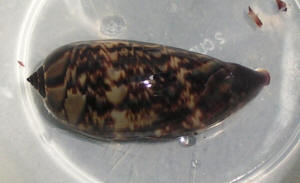 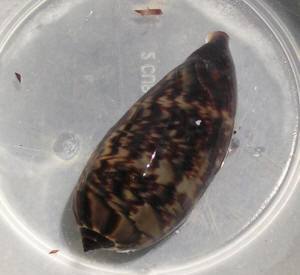 Re: Snail ID: Olive
-- 5/15/09 6/28/13
Hi Bob,
<Hey Lynn!>
I came upon a (very) old query of mine that I believe needs an addendum.
I've been studying Conids for the past couple of months and the more I look
at them, the more I think that the snail in question could well be a Conid
instead of an Olivid. With that in mind, I'd like to see a note added
relaying the need to treat this, and any other snails with this appearance,
as potentially dangerous. It's just not worth the risk.
Here's the link:
http://www.wetwebmedia.com/SnailID20.htm?h=
Thanks!
-Lynn
<Thank you. Will addend/post adjacent. BobF>
|
|
Snail ID: Bullia natalensis - 4/7/09
Hi Crew,
<Hello Mohamed>
Can you please help me ID this snail which is found off the coast
of South Africa? It looks like some type of Nassarius.
<You're very close! They're in the same family,
Nassariidae, but your snail, Bullia natalensis, actually belongs
within a subfamily called Bulliinae. This group of snails is
generally referred to as 'Plough' snails. Although there
are many species of Bullia known to inhabit the waters around
Africa, B. natalensis is particularly common in the surf zone of
Natal's sandy beaches. Please see this link for photos and a
bit more information:
http://www.gastropods.com/6/Shell_4046.shtml >
What is the purpose and function of this snail?
<I guess you could say that it's to keep the beaches
clean. These snails are scavengers that, although completely
blind, have an extremely well developed sense of smell. They use
it to locate dead and dying organisms, either in the shallows or
up on the wet sand of the surf zone.>
Can it be used in aquariums?
<As a scavenger, yes, I would think so but this snail gets
pretty big (up to 6cm/~2 3/8'). It's going to have a big
appetite! You'd have to keep it well fed with meaty bits (of
marine origin). Scavenging snails have been known to turn to live
foods, such as a hobbyist's favorite clam, etc., if/when they
get hungry enough.>
Thanks
Mohamed
<You're very welcome. Take care, LynnZ>
|
[1]%20snail.jpg) |
|
Hitchhiker ID Please 3/23/09
Hello,
I need help identifying this hitchhiker. It resembles a small
Stomatella or Chiton, but I don't think that's what it
is. It's about 1/4" in diameter, very flat. It has two
sensory tentacles on the head, but it also has tentacles about
3/16" long all the way around its body. It moves like a
Stomatella, but slower. It has a broken up burgundy and white
pattern on its back. If region helps, I believe it came in on a
recent shipment of corals
from Kupang. I have attached some pictures, but it was hard to
get a good picture of something so small. By the way, thanks for
all you do for our hobby, I use your site constantly.
Thanks
Matt
<Welcome... I do agree this is a snail of some sort... but I
can't discern much more than you have listed. I would enjoy
it/them and leave them be if not causing trouble out of hand.
Thank you for sharing. Will ask LynnZ for her input here as well.
Bob Fenner>
|
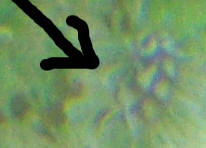 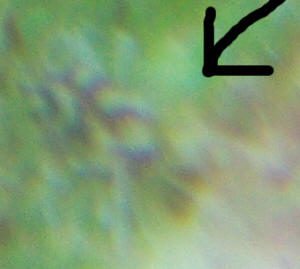 |
Hitchhiker ID Please -- 3/23/09
Hello,
I need help identifying this hitchhiker. It resembles a small
Stomatella or Chiton,
<It's hard to tell from the photos but I'm guessing
it's not all comprised of soft parts? In other words,
there's a shell of some sort present? If so, is it flat,
slightly domed, conical, etc? Do you see any sort of spiral
structure or radiating lines anywhere on it?>
..but I don't think that's what it is. It's about
1/4" in diameter, very flat.
<What's the general outline/shape? Is it basically round
or is it oval/length>width)?>
It has two sensory tentacles on the head, but it also has
tentacles about 3/16" long all the way around its body. It
moves like a Stomatella, but slower. It has a broken up burgundy
and white pattern on its back.
<Is this pattern on what appears to be a shell/hard surface,
or on soft tissue?>
If region helps, I believe it came in on a recent shipment of
corals from Kupang.
<That's great, thanks. Every little bit of information
helps when it comes to ID's.>
I have attached some pictures, but it was hard to get a good
picture of something so small.
<Yep, it can sure be a challenge. Does your camera have a
macro setting (usually indicated by a small flower symbol)? If
so, please do try to get another photo or two and resend. Right
now, I just don't have enough information to be able to
determine what it is. I do agree with Bob though, that it's
likely a snail of some sort.>
By the way, thanks for all you do for our hobby, I use your site
constantly.
Thanks
Matt
<You're very welcome. Take care, Lynn>
|
Re: Hitchhiker ID Please: Juvenile Abalone --
Haliotis asinina 3/24/09
<Hello Matt>
I pulled it out of the tank to get some better
pictures.
<Thank you so much. What a beautiful little
creature!>
To answer your questions, it has a hard shell almost
completely flat and a foot like a snail. It is almost
completely round, but when I photographed it, I noticed it
is a little "U" shaped, or maybe like a kidney
bean shape but flat. The pattern is on the shell part. It
does not appear to bother any livestock.
<Nope, these are herbivores, so no worries.>
It stays in a 1 inch radius of the small indention in the
rock that it is living in.
<Supposedly, these are nocturnal, so yours may well
venture about at night, but return to the same spot in the
morning. I've seen this sort of 'homing'
behavior with urchins. If you didn't know better
you'd swear they never left that one spot!>
It almost appears to filter feed, but definitely not sure
about that.
<They actually feed on various algae species.
Apparently, they prefer Rhodophytes (red algae) such as
Coelothrix, Hypnea, Laurencia and Amphiroa, but will also
feed on Gracilaria/Gracillariopsis. You could try offering
yours some of the commonly available dried (red) seaweed
sheets. The easiest way to present it is to tear off a
piece and attach it to a rock with a rubber band. Simply
set it near the animal, either right before the lights go
out, or afterwards if you have any herbivorous fishes that
would tear the sheet apart.>
The tentacles resemble Aiptasia.
<Yep, what you're seeing is a perimeter of sensory
tentacles.>
Hope this helps.
<Yes indeed! These new photos are exactly what I needed.
If you look closely at the shell, you'll see a line of
respiratory holes (apertures) along the top edge facing the
camera. These are common to Abalone (Haliotis spp.). The
really neat thing, though, is the presence of those little
blue spots. That clinches the ID as a juvenile Haliotis
asinina, aka the Ass's Ear Abalone (because of the
adult shell's supposed resemblance to a donkey's
ear). Personally, I think that's an awful name for such
a little beauty but oh well. These are common shallow water
inhabitants of reef edges, and size-wise top out somewhere
between ~2 3/8' and 4 ¾' (6--12cm).
For more information, please see the following links:
http://www.animalpicturesarchive.com/view.php?tid=2&did=25332
This next link shows the progression of shell
development:
http://www.biomedcentral.com/1471-2148/7/160/figure/F1?highres=y
http://www.gastropods.com/9/Shell_119.shtml
Take care and enjoy your Abalone! LynnZ >
|

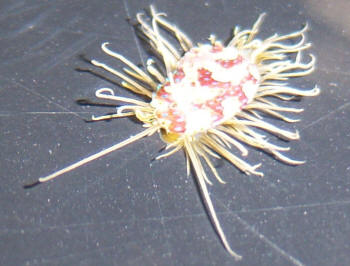
<<Gorgeous!! -Sara M.>> |
|
|
|

